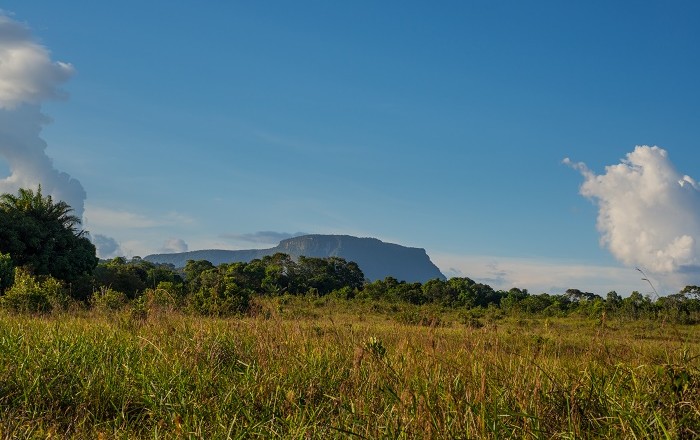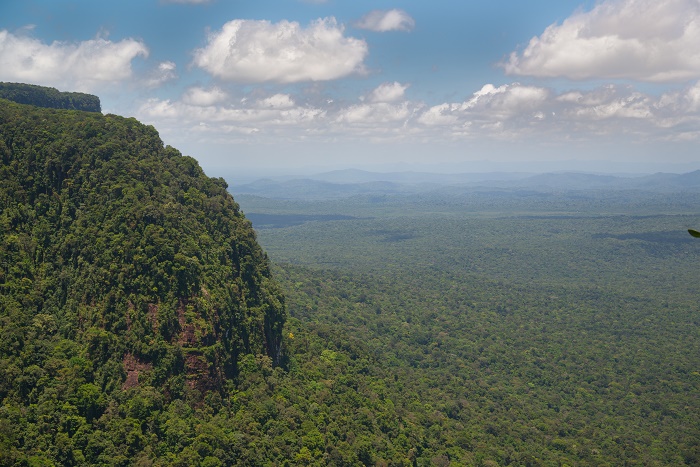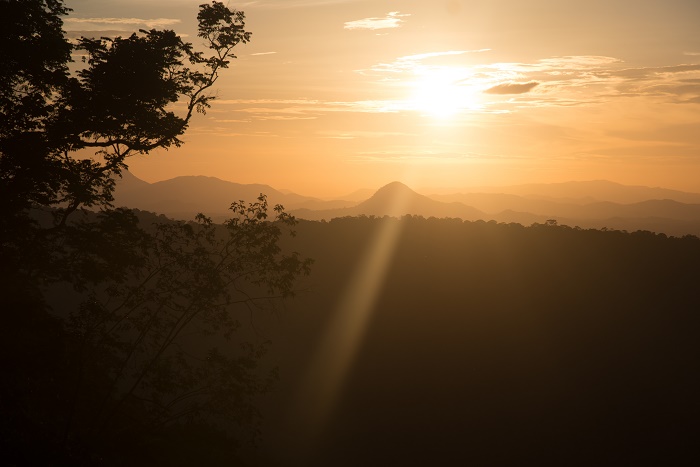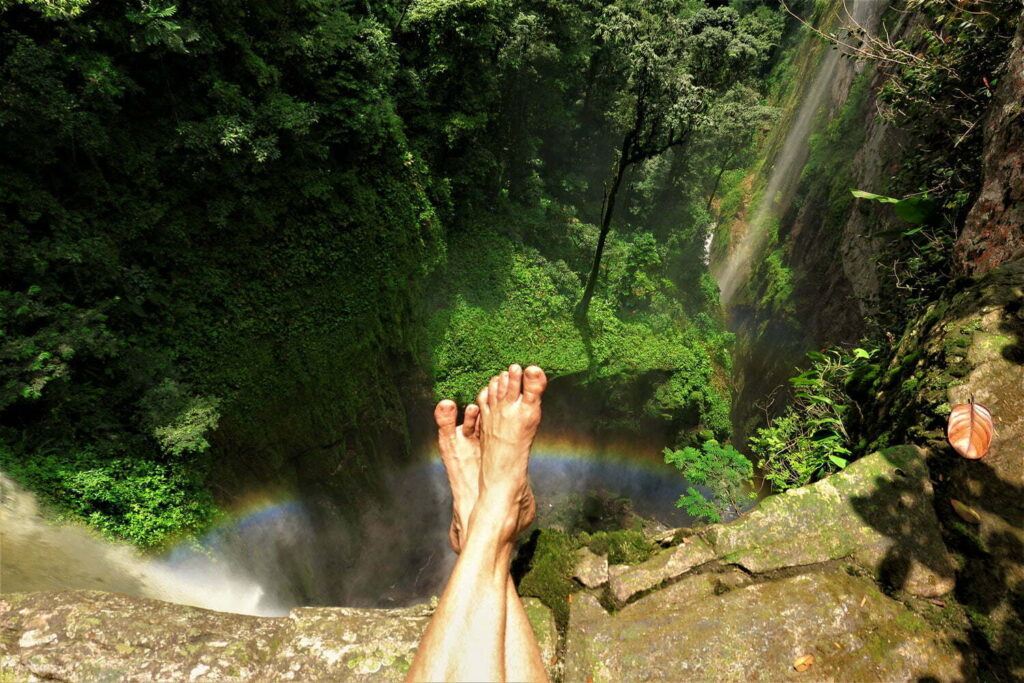Have you ever experienced the breathtaking beauty of Tafelberg Mountain in Suriname? If not, you’re in for a treat! This remarkable mountain, located in the heart of Suriname’s rainforest, is an absolute gem that will leave you in awe. In this article, we’ll explore the scenic allure of Tafelberg Mountain and why it’s a must-visit destination for nature lovers and adventure seekers.
Standing tall at about 1,026 meters, Tafelberg Mountain offers a picturesque landscape that is worth every bit of the climb. Its name, which translates to “Table Mountain” in English, perfectly describes its unique flat summit. When you reach the top, you’re rewarded with panoramic views that stretch as far as the eye can see, giving you a sense of oneness with nature. As you hike through the dense rainforest, you’ll come across an abundance of biodiversity, including rare birds, colorful butterflies, and exotic flora. The journey to the top is not for the faint of heart, but the experience is beyond words. I can’t wait to share more about Tafelberg Mountain and its hidden wonders in the upcoming paragraphs. Stay tuned!

The Origin of Tafelberg Mountain
Tafelberg Mountain, located in the beautiful country of Suriname, is a natural wonder that has captivated visitors for centuries. Its towering peak and distinctive physical features make it a unique and awe-inspiring sight to behold. But have you ever wondered how this magnificent mountain came to be? Let’s delve into the geological processes that formed Tafelberg and the impact of volcanic activity on its structure.
Formation through Geological Processes
Tafelberg Mountain was formed over millions of years through a series of geological processes. It is part of the Guiana Shield, one of the oldest geological formations on Earth. The mountain’s foundation primarily consists of Precambrian rocks, which were created during the Archean Eon, approximately 2.5 to 4 billion years ago.
During the Proterozoic Eon, around 2.5 billion years ago, the rocks that would eventually become Tafelberg were subjected to intense heat and pressure. This resulted in the formation of metamorphic rocks, such as gneiss and schist, which make up the core of the mountain.
Over time, the Guiana Shield experienced various tectonic activities, including folding and faulting. These processes caused the rocks to rise and fold, leading to the formation of mountain ranges, including Tafelberg. The unique geological characteristics of Tafelberg can be attributed to the diverse materials that were uplifted and exposed during these tectonic events.
Volcanic Activity and its Impact on the Mountain’s Structure
Volcanic activity has played a significant role in shaping Tafelberg’s structure. Suriname, like many other regions of the Guiana Shield, experienced volcanic eruptions during the geological past. The molten lava that erupted from these volcanoes contributed to the formation of volcanic rocks, such as basalt and andesite, which are found in abundance on and around Tafelberg.
The presence of these volcanic rocks gives Tafelberg its distinctive appearance, with sheer cliffs and rugged slopes. The hardened lava flows form layers that can be seen in the exposed rock faces, providing clues about the volcanic activity that occurred in the region. These layers also contribute to the mountain’s unique stratigraphy, making it a fascinating spot for geological studies.
Geographical Location and Features
Tafelberg Mountain is situated in the southern part of Suriname, near the borders with Brazil and Guyana. It is part of the larger Tumuc-Humac mountain range, which extends across the borders of multiple countries. The mountain’s location within Suriname offers breathtaking views of the surrounding rainforests, rivers, and savannahs.
Tafelberg Mountain’s Location within Suriname
Suriname, located on the northeastern coast of South America, is a country blessed with diverse natural landscapes. Tafelberg Mountain is situated in the southern region of Suriname, within the Tafelberg Nature Reserve. This protected area encompasses approximately 1,600 square kilometers and is renowned for its pristine rainforests, waterfalls, and diverse ecosystems.
Distinctive Physical Characteristics of the Mountain
Tafelberg Mountain stands tall at an impressive elevation of 1,026 meters (3,366 feet) above sea level. Its name, which translates to “Table Mountain” in Dutch, perfectly describes its flat, plateau-like summit. This distinctive feature sets Tafelberg apart from other mountains in the region, making it a prominent landmark in Suriname.
The mountain’s slopes are covered with dense rainforest, home to a rich variety of plant and animal species. The flora includes towering trees, orchids, bromeliads, and ferns, creating a lush and vibrant ecosystem. As you ascend Tafelberg, you’ll notice the vegetation gradually changing with altitude, offering a unique experience of different microclimates.

Ecological Diversity and Wildlife
Tafelberg Mountain is a paradise for nature enthusiasts, offering a haven for diverse flora and fauna. The mountain’s rich biodiversity contributes to the overall ecological balance of Suriname and provides a habitat for numerous unique and endangered species.
Rich Biodiversity of Flora and Fauna
The rainforests surrounding Tafelberg are teeming with life, showcasing the immense biodiversity of the region. The dense canopy provides shelter and nourishment for an astonishing array of plant species. The presence of different microclimates gives rise to a variety of ecosystems, each supporting its own set of plants and animals.
The lower slopes of Tafelberg are characterized by tropical rainforest vegetation, including towering trees such as the kapok and Brazil nut tree. As you ascend to higher altitudes, the forest transitions into cloud forest, with moss-covered trees, ferns, and epiphytes. These unique ecosystems harbor countless orchid species, known for their intricate beauty and fragrant blooms.
The abundant plant life in the area attracts a wide range of animal species. Tafelberg is home to several monkey species, such as the black spider monkey and the red howler monkey, which can be spotted swinging through the trees. Other endemic mammals include the giant anteater, jaguar, and tapir, although sightings of these elusive creatures require patience and luck.
Endangered Species Found in the Tafelberg Mountain Region
Tafelberg Mountain and its surrounding forests provide a critical habitat for several endangered species. The area is recognized as an Important Bird and Biodiversity Area (IBA), attracting birdwatchers from around the world. The endangered Guianan cock-of-the-rock, the harpy eagle, and the golden-headed cotinga are just a few of the avian treasures that call Tafelberg home.
The mountain also supports various reptiles and amphibians, including the endemic blue poison dart frog. This brightly colored amphibian serves as a symbol of the delicate balance between habitat preservation and species conservation.
Historical Significance
Tafelberg Mountain holds great cultural and spiritual importance to local indigenous communities. Its imposing presence and unique geological features have been sources of inspiration and reverence for generations.
Cultural and Spiritual Importance to Local Indigenous Communities
Tafelberg is considered sacred by the indigenous people of Suriname, particularly the Trio and Wayana tribes. These communities have inhabited the region for centuries, ingraining their traditions and beliefs in the land and its natural elements. The mountain is believed to be a spiritual gateway, connecting the physical and metaphysical realms.
Ceremonies and rituals are often performed on the slopes of Tafelberg, honoring the spirits and seeking guidance from the ancestors. These practices continue to be cherished and passed down through generations, preserving the cultural heritage of the local communities.
Explorers and Adventurers Who Have Ventured into Tafelberg Mountain
Tafelberg’s remote location and challenging terrain have long attracted explorers and adventurers seeking to conquer its summit. Over the years, numerous expeditions have been undertaken, each leaving its mark on the mountain’s history.
One of the earliest recorded expeditions to Tafelberg was led by Paul Crask in 1995. His journey, detailed in the book “Amazon to Antarctica,” documents the physical and mental challenges faced by the team in their quest to reach the mountain’s peak.
Other notable explorers, such as Emilie Demant Hatt, have also ventured into the Tafelberg region. Emilie, a Danish artist and ethnographer, visited Suriname in the early 20th century and documented the lives and culture of the indigenous tribes living in the area.

Trekking Routes and Expeditions
For adventure enthusiasts and nature lovers, Tafelberg Mountain offers a plethora of trekking routes and expeditions to reach its summit. These trails provide an exhilarating experience, allowing you to immerse yourself in the breathtaking beauty of the Surinamese wilderness.
Popular Trekking Trails to Reach Tafelberg’s Summit
The journey to Tafelberg’s summit is no easy feat, but the rewards are immeasurable. Several trekking routes cater to different skill levels and preferences, ensuring there’s an option for everyone seeking to conquer this majestic mountain.
The most popular route is the “Tafelberg Trail,” which starts near the village of Kwamalasamutu. This challenging trek takes you through dense rainforest, crossing rivers and navigating steep inclines. Along the way, you’ll encounter breathtaking waterfalls, explore hidden caves, and witness the incredible flora and fauna of the region.
Experienced hikers may choose to embark on the “Dorpen Trail,” a multi-day trek that connects various indigenous villages in the area. This trail not only allows you to experience the natural beauty of Tafelberg but also provides a unique insight into the cultural heritage and daily lives of the local indigenous communities.
Challenges and Precautions for Climbers
As with any outdoor adventure, climbing Tafelberg Mountain comes with its fair share of challenges and precautions. The rugged terrain, unpredictable weather conditions, and remote location require careful planning and preparation.
First and foremost, it is crucial to be physically fit and mentally prepared for the demanding trek. The steep ascents and descents can be physically strenuous, and the heat and humidity of the rainforest can take a toll on your body. Prior training and conditioning will greatly enhance your chances of successfully reaching the summit.
Secondly, it is essential to be well-equipped with proper gear and supplies. A sturdy pair of hiking boots, lightweight clothing, and a waterproof backpack are essential. Additionally, carrying sufficient food, water, and first aid supplies is crucial, as there are limited resources available along the trekking routes.
Lastly, it is advisable to hire a local guide or join an organized tour. Local guides possess valuable knowledge of the area, including its flora, fauna, and indigenous cultures. They can navigate the trails with ease and provide guidance in case of any emergency situations.
Climbing and Adventure Sports
Beyond trekking, Tafelberg Mountain also offers exciting opportunities for climbing and adrenaline-pumping adventure sports. The rugged cliffs and impressive rock formations make it a haven for thrill-seekers.
Rock Climbing Opportunities on Tafelberg’s Cliffs
Tafelberg’s sheer cliffs beckon climbers from around the world, offering a playground for vertical adventures. With its basalt and andesite formations, the mountain provides a variety of climbing routes suitable for both beginners and experienced climbers.
Scaling these cliffs requires focus, strength, and climbing skills. The routes range from moderate to challenging, with some offering technical challenges such as overhangs and cracks. The reward for reaching the top is an unparalleled view of the surrounding rainforest and a sense of accomplishment like no other.
Paragliding and Other Adventure Sports in the Vicinity
For those seeking an aerial perspective of Tafelberg and its surroundings, paragliding is a popular option. Soaring through the sky, you’ll witness the breathtaking landscapes from a unique vantage point, taking in the intricate details of the rainforest and the vastness of the Surinamese landscape.
Additionally, the Tafelberg region offers opportunities for other adventure sports such as zip-lining, jungle trekking, and river rafting. These activities allow you to explore the natural wonders of Suriname while satisfying your appetite for adrenaline-fueled experiences.

Caves and Rock Formations
Tafelberg Mountain is not only known for its towering peak but also for the hidden caves and unique rock formations that lie within its ancient slopes. Exploring these geological wonders offers a glimpse into the Earth’s history and highlights the fascinating dynamics that shape our planet.
Exploring the Hidden Caves of Tafelberg
The rainforests surrounding Tafelberg are home to a network of hidden caves, each with its own story to tell. Exploring these underground chambers provides a sense of adventure and discovery, as you navigate through narrow passages and marvel at stunning stalactite and stalagmite formations.
One of the most well-known caves in the region is the “Gong Cave.” Its name derived from the resonant sounds produced when stalactites are struck. This unique feature makes the cave a popular spot for music enthusiasts and curious explorers alike.
Unique Rock Formations and their Geological Significance
Tafelberg’s rocky terrain boasts a variety of geological formations, each with its own scientific and aesthetic value. The volcanic origins of the region have created basalt columns and exposed layers of hardened lava, providing a window into the earth’s geological history.
One prominent rock formation is the “Devil’s Woodyard.” This area is characterized by a series of columnar joints, reminiscent of a wooden fence. These hexagonal columns, formed as lava rapidly cooled and contracted, create a visually striking display of geometric patterns and textures.
These unique rock formations not only challenge our understanding of the Earth’s processes but also inspire wonder and awe in those fortunate enough to witness their splendor.
Natural Beauty and Scenic Views
Tafelberg Mountain offers panoramic vistas that are truly a feast for the eyes. The majestic peak provides a vantage point to witness the beauty of Suriname, showcasing its diverse landscapes and natural wonders.
Panoramic Vistas from Tafelberg’s Peak
Reaching the summit of Tafelberg is an accomplishment in itself, but the rewards extend far beyond personal satisfaction. From its flat, table-like plateau, you’ll be treated to uninterrupted views of the surrounding rainforests, rivers, and savannahs.
As the sun rises or sets, the vibrant colors paint the sky, illuminating the landscape in a golden glow. The serenity and tranquility of the moment are unparalleled, offering a moment of pure connection with nature.
Spectacular Sunsets and Sunrises over the Surinamese Landscape
Witnessing a sunrise or sunset from Tafelberg’s peak is a magical experience that leaves a lasting impression. The changing hues of the sky, the gentle caress of the breeze, and the symphony of nature’s sounds create an ambiance that transcends the ordinary.
As the first rays of the sun bathe the land in warm light, the rainforest awakens, filled with the melodic calls of birds and the rustling of leaves. Similarly, as the day comes to an end, the setting sun bathes the landscape in a crimson glow, signaling the transition from day to night.

Photography and Artistic Inspiration
The scenic allure of Tafelberg Mountain has long been a muse for photographers and artists, capturing its beauty in various forms. Whether through the lens of a camera or the strokes of a paintbrush, Tafelberg continues to inspire the creative spirit.
Capturing Tafelberg’s Beauty Through Photography
Tafelberg’s breathtaking landscapes offer endless opportunities for photographers to capture its natural beauty. The dramatic rock formations, cascading waterfalls, and vibrant wildlife provide a wealth of subjects to focus on.
Photographers are drawn to the raw and untamed nature of Tafelberg, aiming to capture its essence and convey the sense of wonder and awe it evokes. From macro photography of delicate orchids to wide-angle shots of the expansive rainforest, each image tells a story and preserves a fleeting moment in time.
Influence of Tafelberg on Local Artists and Artisans
Tafelberg Mountain’s profound presence and striking features have also influenced local artists and artisans. The mountain’s beauty and cultural significance serve as inspiration for various art forms, including paintings, sculptures, and traditional crafts.
Artists often depict Tafelberg in their works, aiming to capture its majestic allure and convey its importance to the Surinamese identity. Paintings may depict the rich colors of the rainforest, the imposing cliffs, or the spiritual energy that emanates from the mountain. Local artisans also incorporate elements of Tafelberg into their crafts, preserving traditional techniques and paying homage to their cultural heritage.
Conservation Efforts and Sustainability
Preserving the natural habitat of Tafelberg Mountain and ensuring its sustainability for future generations is a crucial responsibility. Recognizing its ecological, cultural, and economic value, various conservation efforts and sustainable tourism practices have been implemented in the region.
Preserving the Natural Habitat of Tafelberg Mountain
The Tafelberg Nature Reserve plays a pivotal role in the preservation of Tafelberg’s natural habitat. Protected by the Suriname government, the reserve aims to safeguard the diverse ecosystems within its boundaries and minimize the impact of human activities.
Efforts are made to promote responsible tourism practices and limit the number of visitors to sensitive areas. Sustainable development plans are implemented, ensuring that the local communities benefit from tourism without compromising the fragile ecosystems on which they depend.
Sustainable Tourism Practices in the Region
Sustainable tourism practices are key to ensuring the long-term viability of Tafelberg and its surrounding communities. Local tour operators prioritize environmentally friendly practices, such as waste management and responsible camping techniques, to minimize their ecological footprint.
Additionally, engaging with the local indigenous communities and supporting their initiatives is a significant component of sustainable tourism. Encouraging cultural exchanges and providing economic opportunities for these communities helps preserve their traditions and knowledge, while simultaneously contributing to the region’s sustainable development.
Local Communities and Indigenous Tribes
Tafelberg Mountain is surrounded by settlements of indigenous tribes who have a deep-rooted connection with the land. These communities harbor rich cultural traditions and traditional knowledge that add to the tapestry of Suriname’s heritage.
Traditional Knowledge and Cultural Heritage of Tafelberg’s Neighboring Settlements
The indigenous tribes residing near Tafelberg, such as the Trio and Wayana, possess a deep understanding of the land and its intricate ecosystems. Their traditional knowledge, passed down through generations, provides insights into sustainable practices and the interdependence between humans and nature.
These communities have a profound respect for Tafelberg and its spiritual significance, often incorporating it into their folklore, music, and craftwork. By supporting their cultural initiatives and preserving their way of life, we contribute to the survival of their rich heritage and safeguard the integrity of the surrounding natural environment.
Supporting Local Livelihoods and Community Initiatives
Visitors to Tafelberg can actively contribute to the sustainable development of the region by engaging with local communities and supporting their livelihoods. Craft markets and cultural events provide opportunities to purchase traditional handicrafts and directly support the artisans.
Furthermore, responsible tourism operators work closely with indigenous communities, offering employment and training opportunities. These initiatives empower the local population, allowing them to benefit from tourism activities while preserving their cultural identity and enhancing their quality of life.
Research and Scientific Exploration
Tafelberg Mountain’s ecological diversity and unique geological features provide ample opportunities for research and scientific exploration. Scientists and researchers from around the world have conducted studies in the region, contributing to our understanding of ecosystem dynamics and the Earth’s history.
Biological and Geological Studies Conducted on Tafelberg
Biologists and ecologists are drawn to Tafelberg’s rich biodiversity, conducting studies to better comprehend the interplay between different species and their habitats. These studies contribute to our understanding of the delicate balance of ecosystems and aid in the development of conservation strategies.
Geologists and geoscientists have also conducted extensive research on Tafelberg, aiming to unravel the mountain’s geological history and shed light on the geological processes that shaped it. By studying the rocks and mineral formations, scientists gain insights into the Earth’s past and gain a deeper appreciation for the mountain’s unique composition.
Contributions to Understanding Ecosystem Dynamics
The scientific studies conducted on Tafelberg Mountain and its surrounding areas have significantly contributed to our understanding of ecosystem dynamics. Researchers have identified new species, unveiled previously unknown ecological relationships, and provided valuable data for conservation initiatives.
By combining traditional knowledge with scientific research, there is an opportunity to create a more holistic understanding of the region’s ecosystems. This integrated approach ensures that conservation efforts take into account not only scientific findings but also the wisdom of the local indigenous communities who have lived in harmony with the land for centuries.
Weather and Climate Conditions
The weather and climate conditions surrounding Tafelberg Mountain play a crucial role in planning your visit. Understanding the weather patterns and knowing the best time to visit can enhance your outdoor experiences and increase your chances of a successful trip.
Weather Patterns and Seasons Affecting Tafelberg Mountain
Suriname experiences a tropical rainforest climate, characterized by consistently high temperatures and high humidity throughout the year. However, slight variations in weather patterns can affect the conditions at Tafelberg Mountain, especially during the rainy and dry seasons.
The rainy season in Suriname typically occurs from May to August, with increased precipitation and occasional thunderstorms. During this time, the rainforest thrives, and the waterfalls around Tafelberg are at their most dramatic. However, trekking and climbing activities may be more challenging due to slippery paths and swollen rivers.
The dry season, from September to April, offers more stable weather conditions. The humidity is still high, but rainfall is generally less frequent. This is the recommended time to visit Tafelberg if you prefer drier paths and clearer skies for panoramic views.
Best Time to Visit for Optimal Outdoor Experiences
The best time to visit Tafelberg Mountain for optimal outdoor experiences is during the dry season, from September to April. The weather is generally more predictable, and the trails are less muddy, making for a smoother trekking experience.
If you wish to witness the breathtaking waterfalls at their most powerful, the rainy season can provide a more dramatic backdrop. However, be prepared for wetter conditions and plan your activities accordingly.
Regardless of the season, it is essential to pack appropriate clothing and gear suitable for both rain and shine. Quick-drying clothing, sturdy hiking boots, and waterproof bags are a few essentials to consider when preparing for your adventure.
Conclusion
Tafelberg Mountain offers a captivating blend of natural beauty, cultural significance, and thrilling adventures for those willing to explore its wonders. From its unique rock formations and abundant wildlife to the rich history and traditions of nearby communities, this majestic mountain in Suriname truly encompasses the scenic allure that attracts visitors from all over the world. The pristine rainforests, hidden caves, and panoramic views from the summit make Tafelberg a must-visit destination for nature enthusiasts, photographers, and adventure seekers alike. By preserving its natural habitat, supporting local communities, and conducting responsible tourism practices, we can ensure that the allure of Tafelberg will be enjoyed by generations to come. So, pack your bags, prepare for the journey, and embark on an unforgettable adventure to Tafelberg Mountain, where nature’s splendor awaits your discovery.